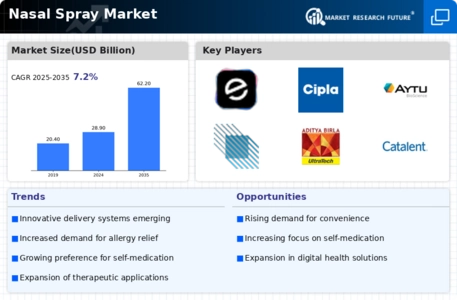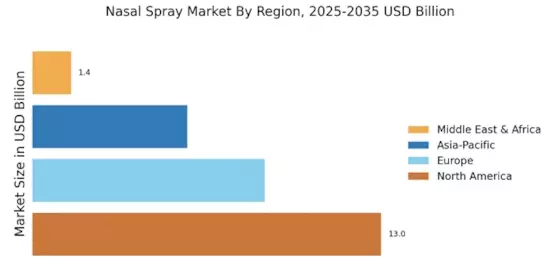Shift Towards Self-Medication
The trend towards self-medication is reshaping the Nasal Spray Market. Consumers are increasingly opting for over-the-counter nasal sprays to manage their symptoms without the need for a prescription. This shift is driven by a desire for convenience and immediate relief, particularly in the context of minor ailments such as nasal congestion and allergies. Market data suggests that the self-medication segment is expanding, with a notable increase in the availability of nasal spray products in pharmacies and retail outlets. As consumers become more empowered to manage their health, the Nasal Spray Market is likely to see a corresponding rise in demand for these accessible treatment options.
Innovations in Delivery Systems
Innovations in drug delivery systems are significantly influencing the Nasal Spray Market. Advances in formulation technology have led to the development of more effective and user-friendly nasal sprays. For instance, the introduction of metered-dose inhalers and novel formulations that enhance drug absorption are gaining traction. These innovations not only improve patient compliance but also expand the therapeutic applications of nasal sprays, including the treatment of conditions beyond allergies, such as migraines and nasal infections. The Nasal Spray Market is expected to experience growth as these technological advancements continue to emerge, offering new opportunities for manufacturers and consumers alike.
Increasing Prevalence of Allergies
The rising incidence of allergic conditions, such as allergic rhinitis and asthma, is a notable driver in the Nasal Spray Market. According to health statistics, allergies affect a significant portion of the population, leading to a growing demand for effective treatment options. Nasal sprays, particularly those containing antihistamines and corticosteroids, are increasingly preferred due to their rapid onset of action and localized effect. This trend is likely to continue as awareness of allergy management increases, prompting more individuals to seek over-the-counter solutions. The Nasal Spray Market is thus positioned to benefit from this growing health concern, with projections indicating a steady increase in sales as more consumers turn to nasal sprays for relief.
Aging Population and Chronic Conditions
The aging population is a critical driver of the Nasal Spray Market. As individuals age, they often experience a higher prevalence of chronic conditions, including respiratory diseases and allergies. This demographic shift is leading to an increased demand for effective treatment options, with nasal sprays being favored for their ease of use and rapid relief. Market analysis indicates that the elderly population is more likely to seek out nasal sprays for managing their symptoms, thereby contributing to the overall growth of the market. The Nasal Spray Market is thus poised to benefit from this demographic trend, as manufacturers adapt their offerings to meet the specific needs of older consumers.
Rising Awareness of Preventive Healthcare
The increasing emphasis on preventive healthcare is driving growth in the Nasal Spray Market. As individuals become more health-conscious, there is a growing recognition of the importance of managing respiratory health proactively. Nasal sprays are being marketed not only for symptomatic relief but also for preventive measures against seasonal allergies and respiratory infections. This shift in consumer behavior is supported by health campaigns promoting awareness of respiratory health, which in turn is likely to boost sales in the Nasal Spray Market. The potential for nasal sprays to serve as preventive tools may lead to an expansion of product lines and formulations tailored to this emerging consumer need.


















Leave a Comment